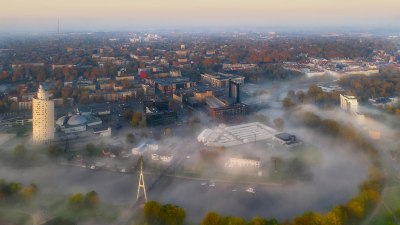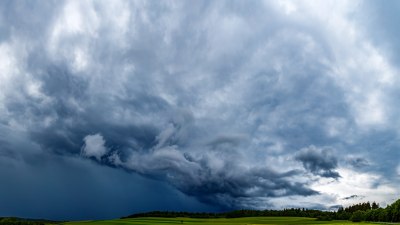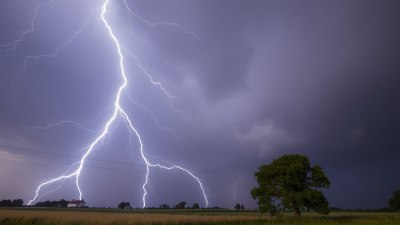How Temperature Inversions Trap Pollution
Discover how temperature inversions contribute to air pollution and their impact on health and the environment.

Temperature inversions are a meteorological phenomenon that can have significant implications for air quality and health. They occur when a layer of warm air traps cooler air at the surface, preventing it from rising. This inversion layer can lead to the accumulation of pollutants, creating smog and harmful air quality. Understanding the mechanisms and consequences of temperature inversions is crucial for addressing air pollution issues.
What is a Temperature Inversion?
A temperature inversion occurs when the normal temperature gradient of the atmosphere is inverted. Usually, the air temperature decreases with altitude; however, during an inversion, a layer of warmer air sits above cooler air. This layer acts as a lid, trapping pollutants close to the ground where they can accumulate. These inversions are typically more common in valleys and during certain weather conditions, such as calm winds and clear skies.
How Do Temperature Inversions Develop?
Temperature inversions can develop in various ways. One common scenario is during the night when terrestrial radiation cools the Earth's surface, causing the air close to the ground to cool while the air above remains warmer. This is particularly prevalent in urban areas where heat from buildings and other structures can retain warmth in the upper layers of the atmosphere.
In addition to radiational inversions, there are also dynamic inversions caused by weather systems. For instance, high-pressure systems can contribute to inversions as they create stable atmospheric conditions, leading to the trapping of air pollutants. These weather patterns can result in persistent inversions lasting for several days, significantly impacting air quality.
Impact on Air Quality
During temperature inversions, pollutants such as particulate matter, nitrogen dioxide, sulfur dioxide, and volatile organic compounds can become trapped. As a result, cities experiencing prolonged inversions may suffer from higher concentrations of smog and haze. Inversions can exacerbate existing air quality issues, leading to increased respiratory problems among the population.
The health implications of poor air quality during temperature inversions are particularly concerning. Increased levels of particulate matter can result in serious health issues such as asthma, cardiovascular disease, and other respiratory illnesses. Vulnerable populations, including children and the elderly, are particularly at risk during these episodes.
Case Study: Los Angeles
Los Angeles is often cited as a classic case study for temperature inversions and their effects on air quality. The city's geography, combined with its warm climate, makes it prone to inversions. During these events, emissions from vehicles, industries, and other sources become trapped, leading to the development of smog. The famous 'Santa Ana winds' can also complicate this scenario, as they can push air pollutants into the basin, creating a toxic mix when the inversion forms.
Mitigating Pollution During Inversions
To combat the effects of temperature inversions, cities need to adopt a multi-faceted approach to air quality management. Policies aiming to reduce emissions from vehicles and industry are critical, especially during known inversion periods. Implementing stringent regulations on emissions, promoting public transport, and encouraging the use of cleaner technologies can mitigate pollution levels.
Public awareness campaigns also play an essential role. Informing residents about air quality forecasts can help individuals take precautions during inversions, such as limiting outdoor activities and using air filtration systems indoors.
Technological Advances in Monitoring Air Quality
Advances in technology have significantly improved our ability to monitor and predict temperature inversions and their associated air quality impacts. Remote sensing technologies and air quality modeling can provide real-time data on pollution levels, allowing cities to respond quickly when inversions occur. Data analytics and machine learning algorithms can also help predict the onset of inversions and facilitate proactive measures to reduce pollution.
Long-term Effects of Temperature Inversions
The long-term effects of temperature inversions on urban air quality can lead to chronic health issues for populations exposed to elevated pollution levels. Over time, increased incidences of respiratory diseases and other health complications may contribute to higher healthcare costs and decreased quality of life. Moreover, prolonged exposure to poor air quality can also affect productivity and economic performance, leading to significant societal impacts.
Global Perspectives on Temperature Inversions
Temperature inversions are not exclusive to Los Angeles; they are a global phenomenon impacting many urban areas worldwide. Cities such as Beijing, Mexico City, and New Delhi experience similar challenges with inversion layers contributing to severe air pollution issues. Understanding the dynamics of these inversions and implementing effective policies can have far-reaching benefits for public health and environmental sustainability.
Temperature inversions play a critical role in trapping air pollution and exacerbating health and environmental problems. By understanding the mechanisms behind these phenomena and their effects on air quality, cities can take proactive measures to improve air conditions and protect public health. Ongoing research, technological advancements, and effective policy implementation will be essential in mitigating the impacts of temperature inversions and ensuring cleaner, healthier air for future generations.











